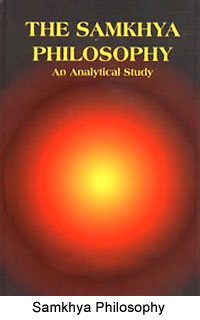 The Samkhya system is based on Satkaryavada. According to Satkaryavada, the effect already exists in the cause. Cause and effect are seen as different temporal aspects of the same thing - the effect lies latent in the cause which in turn seeds the next effect.
More specifically, Samkhya system follows the Prakriti-Parinama Vada. Parinama states that the effect is a real transformation of the cause. The cause under consideration here is Prakriti, or more precisely Mula-Prakriti (Primordial Matter). The Samkhya system is thus an exponent of an evolutionary theory of matter, beginning with primaeval matter. In evolution, Prakriti is transformed and differentiated into multiplicity of objects. Evolution is followed by dissolution. In dissolution the physical existence, all the worldly objects unify back into Prakriti, which now remains as the undifferentiated, primaeval substance. This is how the cycles of evolution and dissolution follow each other.
The Samkhya system is based on Satkaryavada. According to Satkaryavada, the effect already exists in the cause. Cause and effect are seen as different temporal aspects of the same thing - the effect lies latent in the cause which in turn seeds the next effect.
More specifically, Samkhya system follows the Prakriti-Parinama Vada. Parinama states that the effect is a real transformation of the cause. The cause under consideration here is Prakriti, or more precisely Mula-Prakriti (Primordial Matter). The Samkhya system is thus an exponent of an evolutionary theory of matter, beginning with primaeval matter. In evolution, Prakriti is transformed and differentiated into multiplicity of objects. Evolution is followed by dissolution. In dissolution the physical existence, all the worldly objects unify back into Prakriti, which now remains as the undifferentiated, primaeval substance. This is how the cycles of evolution and dissolution follow each other.
Samkhya theorises that Prakriti is the source of the world of becoming. It is pure potentiality that evolves itself successively into 24 tattvas or principles. The evolution itself is possible because Prakriti is always in a state of tension among its constituent strands -
Sattva - a template of balance or equilibrium;
Rajas - a template of expansion or activity;
Tamas - a template of inertia or resistance to action.
All macrocosmic and microcosmic creation make use of these templates. The 24 principles that evolve are -
Prakriti - The most subtle potentiality that is responsible for whatever is created in the physical universe, also called "primordial Matter". It is also a state of equilibrium amongst the Three Gunas.
Mahat - first product of evolution from Prakriti, pure potentiality. Mahat is also considered as the principle responsible for the rise of buddhi or intelligence in living beings.
Ahamkara or ego-sense - the second product of evolution. It is responsible for the self-sense in living beings. It is also one`s identification with the outer world and its subject matter.
"Panch Tanmatras" are a simultaneous product from Mahat Tattva, along with the Ahamkara. They are the subtle form of Panch Mahabhutas which result from `grossification` or `Panchikaran of the Tanmatras`. Each of these Tanmatras are composed of all three Gunas.
Manas or "Antahkaran" evolves from the total sum of the sattva aspect of Panch Tanmatras or the "Ahamkara".
Panch jnana indriyas or five sense organs - also evolves from the sattva aspect of Ahamkara.
Pancha karma indriya or five organs of action - The organs of action are hands, legs, vocal apparatus, urino-genital organ and anus. They evolve from the rajas aspect of Ahamkara.
Pancha mahabhuta or five great substances - The substances comprise ether, air, fire, water and earth. They evolve from the "tamas" aspect of the "Ahamkara". This is the revealed aspect of the physical universe.
The evolution of primal Nature is also considered to be for some purpose - Prakrti evolves for the spirit in bondage. The spirit who is always free is only a witness to the evolution, even though due to the absence of discriminative knowledge, he misidentifies himself with it.
The evolution obeys causality relationships, with primal Nature itself being the material cause of all physical creation. The cause and effect theory of Samkhya philosophy is called Satkaarya-vaada (theory of existent causes), and believes that nothing can really be created from or destroyed into nothingness - all evolution is simply the metamorphosis of primal Nature from one form to another.
The evolution of matter occurs when the relative strengths of the attributes change. The evolution discontinues when the spirit realises that it is different from primal Nature and thus cannot evolve. This ruins the purpose of evolution, thus stopping Prakrti from evolving for Purusha.
Samkhyan cosmology describes how life comes forth in the universe; the relationship between Purusha and Prakriti is essential to Patanjali`s yoga system. The evolution of forms at the basis of Samkhya is quite noteworthy. The strands of Samkhyan thought can be traced back to the Vedic speculation of creation. It is also frequently mentioned in the Mahabharata and Yogavasishta.



















